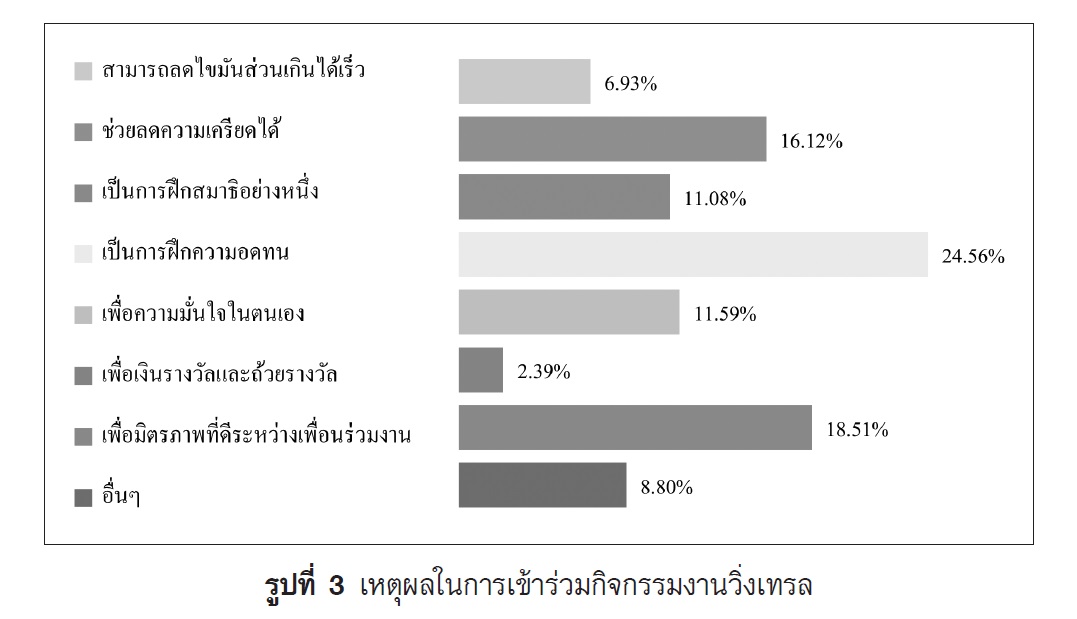THE INFLUENCE OF MARKETING MIX ON SPORTS TOURISM PROMOTION OF THE TRAIL RUNNING EVENTS
Main Article Content
Abstract
Most people seek to perform outdoor sport and activities, especially where it is in close contact with nature under the fresh air. Nowadays, sporting organizations are searching for new locations where it does not attract only athletes but also spectators and companions.
Purpose : The purposes of this research was to study the influence of the marketing mix on participating in the trail running event decision, in the aspect of sports tourism promotion.
Methods : The samples were 296 participatants in the Phu Kradueng Wake Up Run trail running event. The samples were collected by purposive sampling. The research instruments were questionnaires and data were analyzed by frequency, percentage, mean and standard deviation.
Results : It was found that participants in the trail running events had an opinion of the marketing mix in the highest level among 7 aspects, with an average of 4.25. The order was, sorted by the high to low average score, were the people, price, physical evidence and presentation, place, process, promotion, and product and service, respectively.
Conclusion : Our results indicate that the person, price, physical evidence and presentation, and place were factors that influence the marketing mix. Thus, the organizers of the trail running event could apply these results for enhancing the marketing strategies and developing the products or services corresponding to the participant’s demand by focusing on these factors to gain an advantage in competition with competitors and develop products or services to meet the needs of colleagues.
Article Details
References
Bodin, M., and Hartig, T. (2003). Does the outdoor environment matter for psychological restoration gained through running? Psychology of Sport Exercise, 4, 141-153.
Bond, K. A., and Batey, J. (2005). Running for their lives: A qualitative analysis of the exercise experience of female recreational runners. Women in Sport and Physical Activity, 14, 69-82.
Bourdeau, P., Corneloup, J., and Mao, P. (2002). Adventure sports and tourism in the french mountains: dynamics of change and challenges for sustainable development. Current Issues in Tourism, 5, 22-32.
Bowler, D. E., Buyung-Ali, L. M., Knight, T. M., and Pullin, A. S. (2010). A systematic review of evidence for the added benefits to health of exposure to natural environments. BMC Public Health, 10, 456.
Brymer, E., Downey, G., and Gray, T. (2009). Extreme sports as a precursor to environmental sustainability. Journal of Sport and Tourism, 14, 193–204.
Cavaco, C. (1995). Rural tourism: The creation of new tourist spaces. European Tourism: Regions, Spaces and Restructuring, 127-149.
Cole, D. N. (2004). Impacts of hiking and camping on soils and vegetation: A review. Environmental Impacts of Ecotourism, 41,60.
Conboy, J. K. (1994). The effects of exercise withdrawal on mood states in runners. Journal of Sport Behavior, 17, 188.
Daniels, M. J., and Norman, W. C. (2003). Estimating the economic impacts of seven regular sport tourism events. Journal of Sport and Tourism, 8, 214-222.
Duglio, S., and Beltramo, R. (2017). Estimating the economic impacts of a small-scale sport tourism event: The case of the italo-swiss mountain trail collontrek. Sustainability, 9, 343.
Gammon, S., and Robinson, T. (2003). Sport and tourism: a conceptual framework. Journal of Sport and Tourism, 4(3), 8-24.
Getz, D. (2008). Event tourism: definition, evolution, and research. Tourism Management, 29, 403-428.
Hinch, T., and Ramshaw, G. (2014). Heritage sport tourism in Canada. Tourism Geographies, 16, 237–251.
Hoye, R., and Parent, M. M. (2016). The SAGE handbook of sport management. SAGE: Thousand Oaks.
Jeenapak, V. (2012). Domestic tourists satisfaction towards the erawan national park in kanchanaburi. Master’s Thesis, Srinakharinwirot University.
Kotler, P. (2003). Marketing management. New Jersey: Prentice-Hall.
Krein, K. J. (2014). Nature sports. Journal of the Philosophy of Sport, 41, 193-208.
Kuiapai, K. (2009). Cultural tourism : A case study of ban luang nua, luang nua sub-district, doi saket district, chiang mai province. Master’s Thesis, Chiang Mai University.
LaChausse, R. G. (2006). Motives of competitive and non-competitive cyclists. Journal of Sport Behavior, 29, 304-314.
Lamont, M., and Kennelly, M. (2012). A Qualitative exploration of participant motives among committed amateur triathletes. Leisure Sciences, 34, 236-255.
Malchrowicz-Mósko, E., Botiková, Z., and Poczta, J. (2019). “Because we don’t want to run in smog”: Problems with the sustainable management of sport event tourism in protected areas (A case study of national parks in poland and slovakia). Sustainability, 11, 325.
Marion, J. L., and Leung, Y. F. (2011). Indicators and protocols for monitoring impacts of formal and informal trails in protected areas. Journal of Tourism and Leisure, 17, 215-236.
Masterman, G. (2014). Strategic sports event management, Routledge: Abingdon, Oxon.
McCarville, R. (2007). From a fall in the mall to a run in the sun: One journey to ironman triathlon. Leisure Sciences, 29, 159-173.
Ogles, B. M., and Masters, K. S. (2000). Older vs. younger adult male marathon runners: Participative motives and training habits. Journal of Sport Behavior, 23, 130-143.
Puttivisit, P. (2009). Guidelines for tourism development of phitsanulok province. Master’s Thesis, Chulalongkorn University.
Ramshaw, G. (2014). Sport, heritage, and tourism. Journal of Heritage Tourism, 9, 191-196.
Ramshaw, G., and Gammon, S. (2005). More than just Nostalgia? Exploring the heritage/sport tourism Nexus. Journal of Sport and Tourism, 10, 229-241.
Suwuttikul, T. (2009). Readiness and potential of ranong provincial administration organization in historical tourism promotion. Master’s Thesis, Khon Kaen University.
Tangkaew, W. (2011). Cultural tourism management in chiangkhan community, chiangkhan district, Loei province. Master’s Thesis, Chulalongkorn University.
Torbidoni, E. I. F., Seguí Urbaneja, J., and Inglés Yuba, E. (2015). Profiling participants of sporting events in the natural environment: Trails running races. In Sustainable Development of Sports Tourism; AnnalesUniversity Press: Koper, Slovenia, 185-194.
Wilson, R. (2006). The economic impact of local sport events: Significant, limited or otherwise? A case study of four swimming events. Managing Leisure, 11, 57-70.


